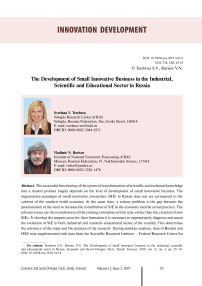The development of small innovative business in the industrial, scientific and educational sector in Russia
Автор: Terebova Svetlana V., Borisov Vladimir N.
Журнал: Economic and Social Changes: Facts, Trends, Forecast @volnc-esc-en
Рубрика: Innovation development
Статья в выпуске: 3 (63) т.12, 2019 года.
Бесплатный доступ
The successful functioning of the system of transformation of scientific and technical knowledge into a market product largely depends on the level of development of small innovative business. The organization paradigm of small innovative enterprises (SIE) in Russia does not yet correspond to the content of the modern world economy. At the same time, a serious problem is the gap between the proclamation of the need to increase the contribution of SIE to the economy and the actual practice. The relevant issues are the revitalization of the existing enterprises of this type, rather than the creation of new SIEs. To develop the support areas for their formation it is necessary to appropriately diagnose and assess the evolution of SIE in both industrial and research-educational sector of the country. This determines the relevance of the topic and the purpose of the research. During statistics analysis, data of Rosstat and HSE were supplemented with data from the Scientific Research Institute - Federal Research Centre for Projects Evaluation and Consulting Services (SRI FRCEC), as well as data from author surveys. The study reveals that the level of SIE development is insufficient to ensure economic security and does not meet the needs of the current stage of the country's economic development. It is revealed that in small enterprises, innovative activity along with financial and personnel issues, is hampered by management problems associated with the fact that the management of manufacturing process of innovative products requires a certain competence and the shift of the company's management resources from current activities. In view of this, the author proposes a model of SIE development management based on the implementation of the project management mechanism in conjunction with “SIE infrastructure”, ensuring the formation of SIE and strengthening its position in the market. We present the results of practical testing of this approach on real research objects, which provided the launch of 33 innovative projects during 2010-2017.
Nnovation, small business, small innovative enterprise, industry, development
Короткий адрес: https://sciup.org/147224186
IDR: 147224186 | УДК: 334 | DOI: 10.15838/esc.2019.3.63.4
Текст научной статьи The development of small innovative business in the industrial, scientific and educational sector in Russia
The need to accelerate the pace of economic development in Russia, as well as ensuring a structural maneuver in industrial manufacturing and income generation against the background of reduced revenues generated by fuel and material sector requires a more complex structure of production and its efficient functioning. These processes are linked to technological change and innovation in real economy. Of course, the key role belongs to large research and technological corporations that determine the country’s technological image. However, it should be borne in mind that the results of functioning of industrial systems depend on the quality of development of all “layers” of business: large, medium and small.
On the one hand, the level of companies’ innovative activity increases in proportion to their size: “from 2.1% (in companies with up to 50 people) and 6.1% (50–99 people.) to 69.5% (5,000–9,999 people.) and 83.7% (10,000 and more)” [1]. On the other hand, it is necessary to keep in mind the “qualitative” differences in the innovation focus of large and small enterprises. For example, 70 out of top 100 major industrial companies in Russia (with the number of employees over 7.5 thousand people) carry out activities in oil and gas production, oil refining, energy, metallurgy, diamond mining and processing, ore mining, production of mineral fertilizers, etc. [2]. It can be assumed that technological innovations in these enterprises producing downstream products (medium-tech or low-tech) are aimed at ensuring their production process, rather than at producing innovative products for their subsequent implementation on the market. However, innovative products of small enterprises are characterized by a high level of novelty: about 80% of their goods (works, services) are connected with real production renewal [3].
The efficiency of small business in the field of innovation is evidenced by foreign statistics, which provides information that small innovative enterprises (SIE) create 2.5 times more innovations per employee and their implementation is carried out 1 year faster than among big businesses, with the cost of 75% less [4].
Moreover, foreign experience proves the possibility of evolution of small innovative enterprises into large businesses. Thus, in the 1970s, one of small enterprises in the US invented a microprocessor, which led to the rapid development of electronics. As a result, major international corporations such as Apple Computers, Compaq, Intel, Lotus, Microsoft, Sun Microsystems grew from small innovative enterprises.
In the national innovation system (NIS), small innovative enterprises act as “experimentalists” and “pioneers”, taking the risks of implementing new developments. Such enterprises provide the transfer of knowledge and technology from the scientific and educational sector to business, transfer the solution of innovative tasks of large enterprises to outsourcing. At the same time, they ensure the interaction of NIS elements. Small innovative enterprises influence the qualitative characteristics of the national innovation system.
Taking all this into account, it is necessary to emphasize that the problem of small business formation and development is an important aspect of the country’s modern technological structure development.
The Strategy for small and medium enterprises (SMEs) development in Russia has the following goal: “the development of small and medium businesses as a factor in innovative development and improvement of the sectoral structure of economy, on the one hand, on the other hand, social development and ensuring a consistently high level of employment” [5]. An increase in the share of SMEs in GDP from 20% to 40% by 2030 is a key goal. The achievement of this indicator is ensured through the allocation of two target groups of SMEs within the Strategy: “mass” and “high-tech” – “exports-oriented enterprises, enterprises in manufacturing and services, fast-growing enterprises (“gazelles”), which introduce innovations and solve the problem of diversification of economy and increase its competitiveness” [5].
In order to engage small enterprises in the system of target transformation of industries and their transfer to the innovative development path it is necessary to deepen and expand scientific ideas about the forms and methods of running small innovative business and the tools of its state support that can ensure the solution of objectives.
Meanwhile, the issues of developing the theoretic and practical tools for SIE development are underdeveloped. The paradigm of small innovative enterprises in Russia does not yet correspond to the content of the modern global economy characterized by a high share of SIE in the greatest share of GDP production (from 40 to 80%), as well as in industrial exports of innovative products (for example, in Germany and The Netherlands, this share is about 40%, in Italy – 20–25%) [6].
Due to the growing complexity of the global economic and national economic systems, an important objective is to accelerate the development of small innovative enterprises. At the same time, a serious problem hindering the solution of this problem is the gap between the need to form small enterprises in science and technology, increasing their contribution to the economy and the real practice of SIE; between the expansion of state support for such companies and the efficiency of the created infrastructure to support SIE. This determines the need to find effective tools and mechanisms to ensure the rapid development of small innovative enterprises and their subsequent consolidation in the market.
Theoretical aspects of innovative entrepreneurship
Entrepreneurship is “an objectively necessary element of modern socio-economic systems; the development of this institution has a positive impact on the labor market as a result of creating new jobs and increasing the demand for labor” [7].
Entrepreneurship was studied by prominent scholars such as P. Drucker, W. Sombart, J.S. Mill, R. Cantillon, A. Smith, J.-B. Say, J. Schumpeter etc. [7]. Summarizing the views of researchers on the understanding of the nature of the studied category, we can conclude that in the classic sense, entrepreneurship (business) is understood as an activity focused on generating income.
Such an approach is also fixed in the Russian legislation. According to the Civil Code of the Russian Federation, business is “an independent activity carried out at one’s own risk, aimed at systematic income generation from the use of property, sale of goods, performance of work or provision of services by people registered according the procedure established by law” [8].
In the economic literature there are two models of entrepreneurship: classic (traditional, reproductive) and innovative. One of the main differences between these models is their degree of risk.
Along with the functions performed by classic small business, innovative entrepreneurship carries out specific functions, in particular, the acceleration of innovative processes and, as a consequence, scientific and technological progress; economic restructuring, etc.
J. Schumpeter was one of the first to introduce a close relationship between entrepreneurship and technological innovation, finding new combinations of production factors. He associated entrepreneurial ability with innovation: “The goal of an entrepreneur is to reform and revolutionize production methods through the introduction of inventions, and more generally – through the use of new technological opportunities for production of fundamentally new goods or production of old goods using a new method, through opening a new source of raw materials or a new market of finished products – up to reorganizing the former industry and creating a new one...” [9].
P. Drucker stressed that “innovation is a special tool of entrepreneurship” used to maximize the income received by an entrepreneur [10].
In modern scientific literature, innovative entrepreneurship is generally referred to as the process of creating and commercializing innovations in products/services that meet new needs and create new market niches.
As it was shown earlier, the organizational form of implementing innovative entrepreneurship is often a small enterprise.
Various interpretations of a small innovative enterprise are given in the scientific and practical literature [11, 12, 13, 14, 15, 16, 17, 18, 19 et al.]. Moreover, in domestic and foreign practice, the following varieties of such enterprises are distinguished: high technology firm, start-up, explerent firm, innovative enterprise, knowledge-based firm, etc. Of course, there are certain differences between them1, but all of them are united by the fact that the main activity of such enterprises is aimed at creating, promoting new products or improving the existing ones.
According to the Oslo Manual, “an innovative firm is a firm which has introduced some innovations during the observation period” [17].
The Russian legislation refers to such enterprises as those whose activity focuses on “practical implementation of results of intellectual activity” [20].
According to the Rosstat methodology, innovative activity of a company is one that “had completed innovation over the past three years, i.e. introduced into the market new or technologically changed and improved products, services or methods of their production (transfer), implemented new or significantly improved production processes new or significantly improved ways of marketing, organizational and management changes” [21].
The Russian legislation defines the following features of classifying the company as a small business: “...average number of employees for the previous calendar year... should not exceed... 100 people for small enterprises (among small enterprises, micro-enterprises up to 15 people are distinguished)..., from 100 to 250 people for medium enterprises. The income... received from business activities for the previous calendar year... must not exceed the limit values.... For small enterprises – 800 million RUB (for microenterprises – 120 million RUB; for medium enterprises – 2 billion RUB)” [22].
The category of domestic small innovative enterprise can include legal entities and individual entrepreneurs who meet the conditions of innovation activity defined by Rosstat, and criteria for small business established by the Russian legislation.
In this context, we can give the following definition of SIE: a small innovative enterprise is an organization with or without the establishment of a legal entity, which in the past three years completed innovations and which refers to a small business according to quantitative criteria.
The analysis of domestic and foreign experience helps identify direct and indirect ways of establishing SIE ( Tab. 1 ). Direct ways include the establishment of a MIP by industrial (the theory of “market pressure”) and education (the theory of “technological shock”) sectors. Along with direct ways of establishing SIE indirect stimulation of their development can be distinguished, which is achieved through innovative infrastructure and large orders by large enterprises for small businesses to develop and produce innovative products.
Direct ways of establishing SIE are the most common in domestic economy. As for establishing SIE by the research-and-education sector, the key role in this process belongs to Federal Law no. 217-FZ adopted in 2009 [23], according to which universities and research institutions were granted the right to register small enterprises
Table 1. Ways and initiators of SIE establishment
|
Ways to establish SIE |
Initiator of SIE establishment |
|
Direct |
Research-and-education sector |
|
- research-and-education institution |
|
|
- individual developer/development team |
|
|
Manufacturing sector |
|
|
- major enterprise |
|
|
- small/medium enterprise (goes into the category of SIE) |
|
|
- SIE |
|
|
Indirect |
Innovation infrastructure organizations |
|
Major enterprise (as a customer) |
independently for the implementation of results of their intellectual activity.
Thus, small innovative business in the country was expanded through the establishment of SIE at research-and0education institutions (SIE at REI), which expanded state support for this sector.
In order to manage the development of SIE and assess its state support measures, appropriate diagnostics and analysis of the performance of this type of business is required. However, the scientific literature presents the results of analysis of trends in the functioning of either SIE in the manufacturing sector or SIE at REI. From our point of view, to form a complete image of SIE development in the country it is necessary to conduct a comprehensive analysis of small innovative enterprises in both sectors.
Methodological framework for assessing the development of small innovative business
Statistical monitoring of innovation activities of small businesses has been conducted in the country since 1999. Surveys are conducted every two years (odd years). For this purpose, a special form of statistical observation no. 2-MP innovation “Information on technological innovation of small enterprises” [24] was developed. The observation object is legal entities – small businesses engaged in economic activity in manufacturing and power generation. It is noteworthy that the study of indicators characterizing innovative activity of small enterprises is carried out without taking into account micro-enterprises2. At the same time,
84% of small manufacturing enterprises are micro-enterprises. Moreover, 5.6% of individual entrepreneurs operate in manufacturing, but the accounting of their innovation activity is not carried out. As follows from the definition above, both these categories can be attributed to small innovative business if they meet the established criteria.
The Rosstat survey on innovation covers an insignificant number of small business entities relative to the total number. At the same time, data on innovation activity of small enterprises are published by Rosstat to a limited extent. At the website of this service3 only three indicators characterizing the activities of small enterprises in the creation and implementation of R&D are presented: level of innovation activity; volume of innovative products; cost of technological innovation. More information on innovation activities of SIE in the industrial sector can be obtained from HSE publications4.
Another source of statistical data for analyzing small business innovations in the country is data of the monitoring study of SIE activities at universities and budget research organizations conducted by Scientific Research Institute – Federal Research Centre for Projects Evaluation and Consulting Services (SRI FRCEC)5. According to the orders of the Ministry of Education and Science of Russia [25, 26], SRI FRCEC forms a quarterly Register of notices on establishment of business companies and business partnerships for further submission of data to the tax administrations. Moreover, the list of SIE at REI is included in the Unified register of small and medium businesses [20] introduced in 2016.
The monitoring study of activities of SIE at REI is carried out on the basis of questionnaires of their founders. For this purpose, two questionnaires have been developed: “Evaluation of the mechanism for practical application of REI through SIE establishment by educational and research institutions” and “Information on SIE activities”. The data provide an idea of the problems and benefits of creating SIE, as well as characterize the results of intellectual activity, revenues, profit, personnel support, and investment. Details of statistical observations are reflected at SRI FRCEC website and in publications, in particular, in “Expertise and innovation”.
The analysis shows that information on the innovation activities collected by Rosstat and SRI FRCEC covers various groups of small enterprises ( Tab. 2 ). Rosstat does not assess the innovation activities of micro-enterprises, and the average number of employees of SIE at REI is 3–4 people. [27]. Moreover, Rosstat survey only covers SIE in manufacturing.
Thus, the innovative activity of a number of small businesses studied by SRI FRCEC and Rosstat only intersect to a very small extent. Based on data published by both services, we determine the following statistical indicators for the analysis of innovation activities of SIE at REI and in manufacturing ( Tab. 3 ).
Table 2. Parameters of statistical observations over SIE activity
|
Parameter |
Rosstat |
SRI FRCEC |
|
Year of the beginning of observation |
1999 |
2014 |
|
Type of statistical observations |
Selective |
Unbroken |
|
Period of observation |
Every 2 years (odd years) |
Yearly |
|
Category of surveyed enterprises |
Small enterprises |
Micro- and small enterprises |
|
Types of economic activities of the surveyed enterprises |
Industry and energy |
All types of economic activity |
|
Type of innovation |
Technological innovations |
All types of innovations |
Table 3. List of statistical indicators for analysis
|
No. |
Indicator |
Measurement unit |
SIE |
SIE at REI |
|
General sector characteristics |
||||
|
Number of enterprises |
units |
+ |
+ |
|
|
Number of employees |
People |
+ |
+ |
|
|
Level of innovation activity |
% |
+ |
- |
|
|
Distribution of enterprises by type of economic activity |
- |
+ |
- |
|
|
Distribution of enterprises in priority areas of research, technics and technology in Russia |
- |
- |
+ |
|
|
Resource support for innovative activity |
||||
|
Cost of innovation |
RUB |
+ |
- |
|
|
Structure of innovation cost |
- |
+ |
- |
|
|
Attraction of investments for innovations development |
RUB |
+ |
+ |
|
|
Results of innovative activities |
||||
|
Revenues from innovation |
RUB |
+ |
+ |
|
|
Shipped innovative goods, works and services of enterprises per RUB of innovation cost |
RUB |
+ |
- |
|
|
Other |
||||
|
Sources of innovation |
- |
+ |
+ |
|
|
Consumers of innovative products |
- |
+ |
+ |
|
|
+ - availability of data for analysis. |
||||
Moreover, survey data from organizations in both sectors can be used to obtain additional information for analysis on a number of parameters such as the enterprise innovation management system.
SIE activities in manufacturing
According to Rosstat, in 2017 technological innovations in the country were carried out by 1,437 small enterprises, the average number of their employees amounted to 70.75 thousand people6 [28].
Throughout the period of statistical surveys, the level of innovation activity of small businesses remains low until: it did not exceed 1.6% ( Fig. 1 ) until 2005. The highest growth rate (2.7 percentage points) was observed in 2007 (4.3%). This is partly due to the exclusion of micro-enterprises [22] from the surveyed sampling according to Federal Law. Over the next 10 years, the indicator grew by 0.9 percentage points to its maximum value in 2017 (5.2%).
The branches of industrial production in small business are characterized by low innovation activity. The exception is the high-tech sector ( Fig. 2 ). Manufacturers of computers, electronic and optical products (19.2%); medicines and materials for medical purposes (16.8%) reached the highest value of the indicator. The outsiders are textiles (2.1%); clothing (2.7%), wood processing (3%), leather and leather goods (3.4%), water supply and disposal (2.1%) and production and distribution of electricity, gas and water (2.4%).
Innovation activity directly depends on the company’s costs of its development. Analysis of performance of this type of costs of small enterprises shows that during 2000–2017, they increased almost four times in comparable prices ( Fig. 3 ). However, in 2017, their absolute volume in current prices was only 19.22 bln RUB [29]. To compare, the same indicator of large and medium enterprises amounted to 1 404,98 bln RUB [29], i.e. 73 times more.
Figure 1. Innovative activity of Russian industrial enterprises [29]
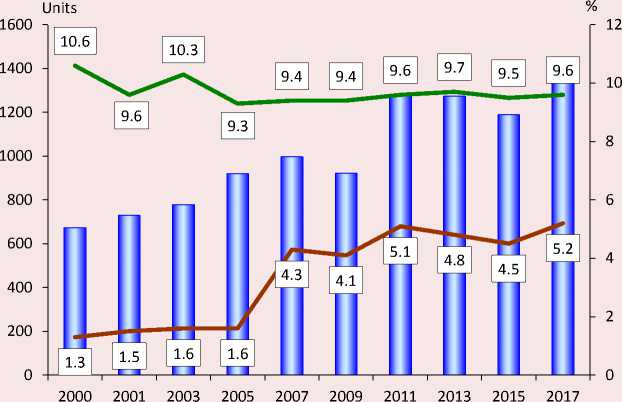
Year
Number of small industrial enterprises that carried out technological innovations, units.
^^^^^е Share of small industrial enterprises that carried out technological innovations in the total number of small enterprises surveyed, %
^^^^^ Share of large and medium industrial enterprises carrying out technological innovations in the total number of surveyed enterprises, %
Figure 2. Innovative activity of small industrial enterprises by type of economic activity in 2017 [29]
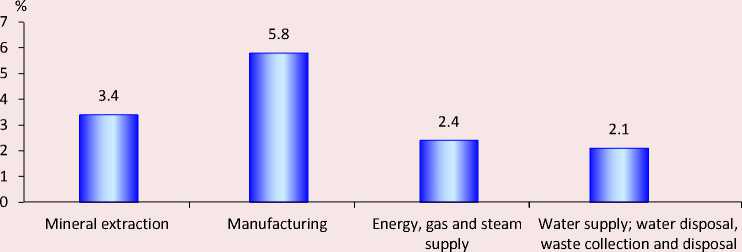
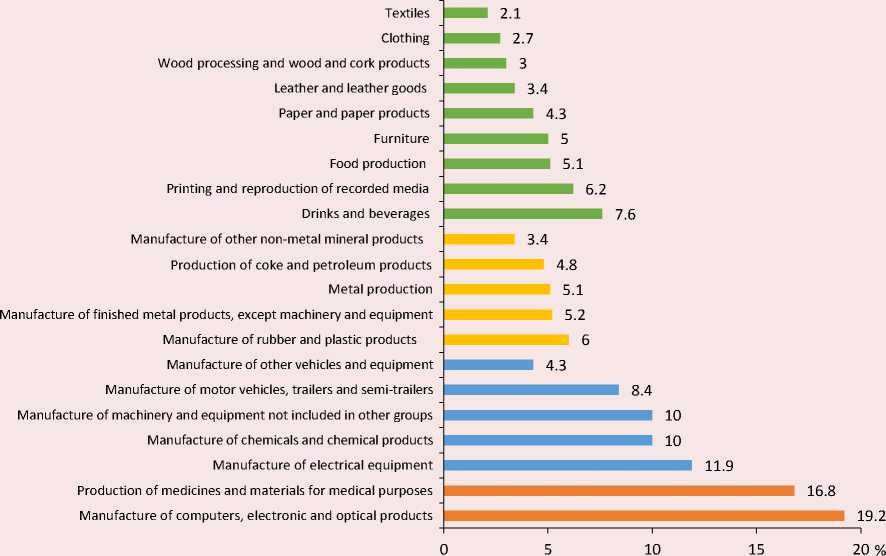
^™ High-tech Low-level med-tech
^™ High-level med-tech Low-tech
Small enterprises are extremely “sensitive” to the overall economic situation in the country, which is reflected in their costs of innovation. Thus, after the peak growth of costs in 2007, they fell by 53%76 in 2009 due to the impact of the 2008 crisis. The sanctions in 2014 and the consequent adverse consequences for the country’s economy also reduced the indicator in 2015 by 22%87 compared to 2013.
In 2017, relative to 2015 there was an increase in the costs of innovation. The study of the indicator in the context of economic activities of enterprises indicates that its growth was achieved due to a significant increase in investment in innovative activities of enterprises engaged in mineral extraction (4.6 times growth9), production of paper and paper products (4), production and distribution of
Figure 3. Performance of costs of technological innovations of small industrial enterprises, mln [29, 30, 31]
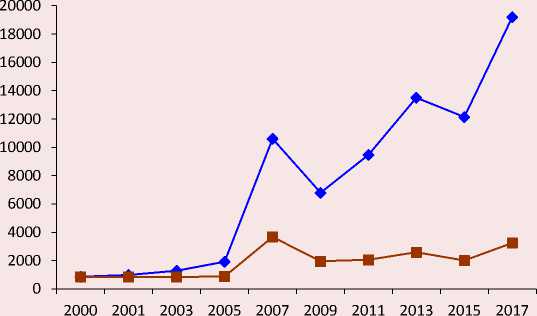
— ♦ — Cost of technological innovations of small industrial enterprises in current prices, mln RUB
— ■ — Cost of technological innovations of small industrial enterprises in the prices of
2000, mln RUB
electricity, gas and water (2.8), wood processing (2.6), production of other non-metal mineral products (1.9) and chemical production (1.7 times) [29]. The costs were mostly increased by low-tech and low-level medium-tech companies. This is probably due to the need to modernize production base, which led to purchase of new equipment and machinery. These items account for the largest share (41.9%) of costs of technological innovation at small enterprises ( Fig. 4 ). The smallest share (0.2%) accounts for training of personnel engaged in development, implementation, promotion of innovations, and marketing research (0.4%). We emphasize that this approach does not meet modern technological development and indirectly affects innovation efficiency.
Low costs of innovation at small enterprises is due to their limited financial capabilities [32]. Judging by the data in the works [30, 33, 34], the main investor in their activity is enterprises themselves. Almost 70% of their own funds accounts for technological innovations [30]. Loans account for only 14.4% (of which only 2.7% are received on concessional terms) [30]. Budget financing accounts for even less – 8.5% (of which only 0.8% are funds of budgets of the country’s constituent entities and local budgets) [30].
The study [35] shows that there is no positive dynamics in the sphere of investment processes of industrial enterprises.
The absolute volume of innovative products in small business for 2000–2017 increased more than fivefold ( Tab. 4 ). In 2017, it amounted to 37.5 bln RUB in current prices [28]. Although the indicator is growing in absolute terms, in relative terms it has been decreasing after 2013. It is noteworthy that in the same period this indicator decreased by 2 percentage points at large enterprises, while at small enterprises – by 0.48 percentage points – to 1.59% in 2017.
However, there are divergent trends in different activities. According to statistics, enterprises the highest share of costs technological innovations produce more innovative products that average. The highest indicator values are demonstrated by enterprises engaged in high-tech sectors (6.8%), including production of electronic components, radio, television and communications equipment
Figure 4. Structure of costs of innovative activity at SIE in 2017 [28]
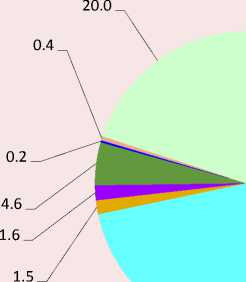

29.2

-
■ Design
Purchase of machinery and equipment
Purchase of new technologies
-
■ Purchase of software
-
■ Engineering
-
■ Personnel training
-
■ Marketing research
Other
Table 4. Performance of volume of innovative goods, works and services at industrial enterprises [28, 29]
|
Indicator |
Year |
|||||||||
|
2000 |
2001 |
2003 |
2005 |
2007 |
2009 |
2011 |
2013 |
2015 |
2017 |
|
|
Volume of shipped innovative goods, works, services at small enterprises in current prices, bln RUB |
0.93 |
1.08 |
1.12 |
3.10 |
12.64 |
10.21 |
16.39 |
27.13 |
31.27 |
37.5 |
|
Volume of shipped innovative goods, performed works, services at small enterprises in fixed prices of 2000, bln RUB |
0.19 |
0.19 |
0.15 |
0.3 |
0.92 |
0.62 |
0.76 |
1.10 |
1.10 |
1.2 |
|
Share of innovative goods, works, services in total volume of goods shipped, works performed, services at small enterprises, % |
0.15 |
0.15 |
0.13 |
0.07 |
0.03 |
1.38 |
1.48 |
2.07 |
1.64 |
1.59 |
|
Share of innovative goods, works, services in total volume of goods shipped, works performed, services at large and medium enterprises, % |
4.4 |
n/a |
n/a |
5.0 |
5.5 |
5.0 |
6.3 |
9.2 |
8.4 |
7.2 |
|
Volume of shipped innovative goods, works, services at small enterprises per ruble of costs for technological innovations, RUB |
1.1 |
1.1 |
0.9 |
1.6 |
1.2 |
1.5 |
1.7 |
2.0 |
2.6 |
1.95 |
|
Volume of shipped innovative goods, works, services of large and medium enterprises per ruble of costs of technological innovations |
3.1 |
n/a |
n/a |
4.3 |
4.4 |
2.4 |
3.9 |
4.1 |
3.2 |
3.0 |
(8.9%), and medical equipment and devices (8.8%) [3]. In the EU countries, this figure is over 60% [36].
Consumers of SIE products are mainly other small industrial enterprises, large enterprises, less often products are sold to the consumer market. The share of public procurement is extremely small – about 5% [29].
According to [38], more than 60% of small innovative enterprises developed innovations on their own; another 16.4% – with the involvement of third parties; 5.8% – through changing products developed by other organizations. Our research shows [39] that enterprises have accumulated, yet not materialized developments, whose commercialization is a necessary condition for starting the transition from an extensive to innovative type of enterprise development.
Along with the logistical, financial and marketing problems, lack of personnel is also an acute issue for SIE [35]. And it is often associated with lack of innovative managers who can ensure commercialization of the enterprise’s existing developments [32,
40], which is expressed in the presence of management problems.
According to the results of analysis of data which we obtained through surveys109 of innovations at small enterprises [40, 41, 42, 43], we can conclude that the majority of them does not have a strategic plan, including the areas of innovative development. There are no departments or employees responsible for innovations in the structure of enterprises; intellectual property management is not organized. Only a third of enterprises have a system which stimulates inventive and innovation activity. This suggests that issues related to intensification of innovation activities are not yet among top priorities of surveyed managers. The management methods in this direction are used very poorly. The activity on realization of innovative potential is a single manifestation, rather than a strategic direction of enterprise development.
Activities of SIE established at educational institutions
The Register of notices on establishment of business companies and partnerships [44] as of January 21, 2019 contains data on establishment of 2,890 SIE, 531 of them (18%) are excluded from the Register. In authorized capital of SIE their founders introduced the right to commercialize more than 3.1 thousand results of intellectual activity.
The largest number of SIE was registered in 2011 (526), the smallest – in 2018 (84; Fig. 5 ). It is noteworthy that the scale of establishment of SIE after 2011 steadily decreases. This may indicate the exhaustion of research and technological developments of universities with sufficient potential for commercialization in the Russian conditions.
-
10 The survey results formed a database with copyright incorporation certificates at the Federal Service of Intellectual Property: no. 2012620336; no. 2012620526.
Figure 5. Scale of establishment of economic partnerships in research and education [44]
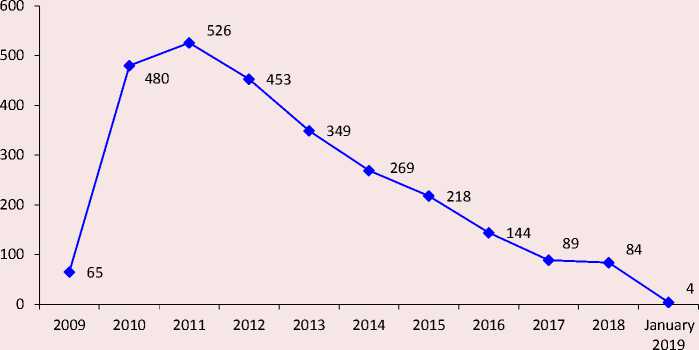
Table 5. Distribution of small enterprises by federal districts (FD) [29, 44, 45]
|
Territory |
Number of small enterprises *, units 1) |
Number of SIE established according to Federal Law no. 217, %1) |
Level of innovation activity of industrial SIE, %2) |
|
|
units |
% |
|||
|
Russia |
222755 |
2890 |
100 |
5,2 |
|
Including: |
||||
|
Central FD |
80845 |
826 |
28.57 |
5.8 |
|
Volga FD |
40982 |
190 |
18.39 |
5.2 |
|
North-West FD |
28886 |
109 |
11.64 |
5.5 |
|
Siberian FD |
22415 |
531 |
20.3 |
5.6 |
|
Ural FD |
18056 |
336 |
7.6 |
4.6 |
|
South FD |
17182 |
92 |
6.56 |
4.4 |
|
Far-East FD |
10058 |
587 |
3.77 |
2.6 |
|
North Caucasian FD |
4331 |
220 |
3.17 |
2.9 |
|
* Legal entities, excluding micro-enterprises. 1)– data as of January 2019. 2)– data for 2017. |
||||
Quarterly analysis of SIE registration data [44] shows that the largest number of them is created in the fourth quarter, which may indirectly indicate the registration of fictitious SIE for reporting to correspond to certain performance indicators.
About 70% of small innovative enterprises are established in research-and-education institutions of three federal districts ( Tab. 5 ):
Central (28.6% of the total number of SIE at REI), Siberian (20%) and Volga (18%).
The main benefits from establishing SIE, according to their founders, are: “increasing the prestige of an institution (4.22 out of 5 points11); introducing to the market those REI promising for the commercialization (4.17); improving the position of an institution in the rankings by increasing relevant indicators”, etc. [27].
Figure 6. Distribution of SIE at REI in priority areas of science, technology and engineering in Russia, % [48]
13.5
15.2
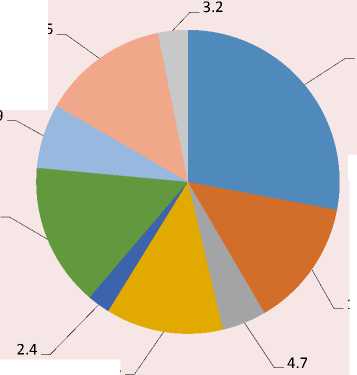
28.0
13.6
12.5
Not specified
-
■ Energy efficiency, energy saving, nuclear energy
Transport and space systems
Environmental management
Promising types of weapons, military and special equipment
Life sciences
Information and telecommunication systems
Nano industry
Security and counter-terrorism
As for the level of innovation activity of SIE at REI, hypothetically it should equal 100% since all enterprises created according to Federal Law no. 217 should be aimed at commercialization of intellectual property. In fact, judging by the results of the research [46], about 10% of such SIE are focused on innovation.
The work by SRI FRCEC experts [47] presents the structure of distribution of SIE at REI by priority directions of science, technology and engineering in Russia ( Fig. 6 ). Figure 6 demonstrates that the largest number of enterprises carry out activities in energy efficiency, energy saving, nuclear energy (13.6% of SIE at REI), environmental management (12.5%), bio-sciences (15.2%), nano-systems (13.55%), a third of enterprises did not specify their profile.
As of the end of 2016, the number of employees1210 of SIE at REI amounted to 8,729
people1311 [27]. In the same year, 80% of SIE in science and education had an annual revenue of up to 1 mln rubles, of which 60% – zero revenue, 5% – up to 100,000 rubles [27].
The structure of customers of SIE products/ services which demonstrated non-zero revenues was as follows: the vast majority – 62.7% – accounted for enterprises, 11% – SIE founders, 4.1% – federal budget, 0.8% – budget of Russia’s entities [27]. Another 22.1% of products/services were sold in the consumer market.
According to the survey [27], only 11% of SIE attracted funding. The structure of these funds by source is as follows: 62.5% – loans and borrowings, 29.6% –fund resources14, 5.5% – budget funds (in the form of subsidies, budget loans), 2.5% – funds of the founder. Consequently, most of the resources comes from loans and borrowings. The total amount of funding in 2016 comprised 2.8 bln rubles. However, only 3% of surveyed enterprises used this source of financing [27].
SIE at REI, as well as industrial SIE face an acute problem of staffing. According to the questionnaire survey of founders of SIE at REI, “the greatest obstacles to establishing a new SIE are as follows: the load on the teaching staff and employment of researchers prevents them from engaging in commercialization of results of intellectual activity (RIA) (3.75 out of 5 points15); evaluation and legal protection of RIA require organizational and financial costs and efforts (3.67); there is not enough initiative from people ready to lead SIE (3.62); authors of RIA are not always interested in their commercialization through the mechanism of SIE establishment (3.46); the established SIE require constant consulting, organizational support (3.37)”, etc. [27].
The main reasons impeding commercialization of RIA through the mechanism of SIE highlighted by their heads are the following: lack of state preferences of SIE (3.91 out of 5 points); universities and research institutions lack business skills for successful establishment of SIE (3.87). Moreover, heads of SIE note lack of information about market prospects [49]. Thus, the problem of management for small innovative enterprises at scientific and educational institutions is also extremely acute and is not resolved with the existing support infrastructure.
Performance of small innovative business development: conclusions according to analysis results
According to analysis results based on available statistical and survey data the following conclusions can be drawn.
-
1. The scale of innovation by small enterprises operating in industrial and research-and-education sector of Russia is insignificant.
-
2. In quantitative terms, the dynamics of the number of SIE at REI decreases annually, which indicates a decline in the pace of this process. The number of industrial SIE demonstrates an upward trend during the period under review. Periods of decrease in their number correlate with crisis situations in the country’s economy.
-
3. A significant disadvantage of small innovative business development is its high territorial concentration. About 70% of SIE are established in research-and-education institutions of three federal districts: Central (28.6% of the total number of SIE at REI), Siberian (20%) and Volga (18%). These districts also demonstrate the highest level of innovation activity of industrial SIE.
-
4. In the sectoral context, innovative activity of small enterprises is unevenness and strongly polarized.
-
5. Quantitative parameters characterizing innovative activity of industrial SIE are higher than those of SIE at REI. On average, one industrial SIE accounts for 49 people, the average revenue per SIE is 26.1 thousand rubles. Similar indicators are for SIE at REI – 3–4 people and 12.7 thousand rubles, respectively. However, if we compare the average revenue and average number of employees at an enterprises, it turns out that SIE at REI work with greater efficiency.
-
6. More than 60% of SIE at REI operate with zero revenue, which is extremely
-
7. The resource capacity of SIE in both sectors is a major factor limiting the development of innovative activity.
-
8. The innovation efficiency of small enterprises remains low.
-
9. The key problems, along with lack of financial, technical and technological resources, are management issues due to the lack of a established system of management of development processes of innovative production and a low level of innovative management. An important factor is lack of financial opportunities for staff expansion to establish a sector responsible for innovation development (the existing personnel is loaded with the current work related to the industrial/ academic/research process).
inefficient from the point of view of market economy. In industry, the company with zero revenue will fail because its content will be devoid of economic sense, and SIE at REI will remain in demand in such a situation since it can be used for reporting. As a rule, the key motive for innovation of an industrial SIE is competition, while for SIE at REI it is good reporting as well (which, in fact, also serves as an indirect competitive advantage, yet in the environment of other universities and research institutions, rather that in the innovation market).
Thus, our analysis shows that there are similar problems in the development of SIE in both sectors of economy. The innovative activity of Russian small enterprises is extremely low, which only suggests their low potential and brings forward the search for ways to activate the existing enterprises, rather than establishing new ones.
SIE management problems and solutions
The analytical part of the article states that to help small enterprises become innovative it is critical to address management problems due to lack of their own competencies and difficulties caused by the distraction of management resources of the company from the current activities.
It should be noted that the circumstances for implementing innovation management have significant similarities with the conditions of the project activities [40, 50]. The efficiency of active implementation of the project approach in the management system at enterprises is confirmed by both foreign experience and experience of large enterprises. In the latter case, in order to apply the approach under review project offices are created, which are structures that support the implementation of innovative project management processes. However, small enterprises do not have such an opportunity. Therefore, the article proposes the implementation of the project approach at an enterprise with the involvement of resources of innovation infrastructure organizations ( Fig. 7 ).
The developed model is primarily focused on the final stages of the innovation process, where the elements of project management associated with the design and formulation of objectives are already solved. That is, it is aimed directly at commercializing the existing results of intellectual activity.
A distinctive feature of the model is that it accounts for the division of the project processes into those aimed at obtaining an innovative product and those aimed at managing processes of its development from the stage of initiation to implementation on the market. The model includes experimentally selected methods and tools for project implementation management at real research facilities, which are taken over by the organization of innovative infrastructure ( Tab. 6 ).
The chosen methods and tools correspond to the objectives to be solved addressed within the framework of the project approach in the
Figure 7. Model of interaction in the application of project approach in a small innovative enterprise with attracting resources from organizations of innovative infrastructure
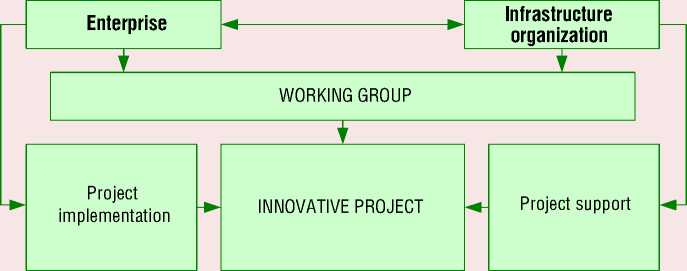
Table 6. Methodological support for project management at enterprises with the participation of organization of innovative infrastructure [50]
|
Function of project management |
Method and tools |
|
Initiation |
Technological audit |
|
Identification and description of technological potential (proposals) and /or technological needs (requests) |
|
|
Market research |
|
|
Assessment of availability of fixed assets and necessary space for the project |
|
|
Assessment of availability of necessary employees (number and their qualifications, experience in bringing innovative products to the market) |
|
|
Registration of intellectual property rights |
|
|
Search for project financing sources |
|
|
Planning |
Development of the project implementation schedule |
|
Development of production plan and sales plan |
|
|
Development of financial plan (budgeting) |
|
|
Identification and assessment of possible types and sources of risks, development of measures to reduce them |
|
|
Development of proposals for the formation of a team of qualified experts (management, engineering and technical personnel, marketing experts) necessary for the implementation of the innovative project. Development of a scheme to attract specialists |
|
|
Development of organizational structure of the management system |
|
|
Development of a business plan |
|
|
Execution |
Attracting investment for the implementation of an innovative project |
|
Finding partners for the project |
|
|
Providing methodological and information support to project participants |
|
|
Support of innovative project |
|
|
Coordination of project implementation |
Preparation of records of meetings, working groups, memorandums of agreement |
|
Redirection of clients to partner organisations |
|
|
Control |
Development of project reporting for different management levels |
|
Monitoring of the current state of the project and management reporting |
|
|
Monitoring the communication system functioning |
|
|
Completion |
Registration of intellectual property rights |
|
Preparation of research-and-technical report on project implementation |
|
|
Preparation of financial statements |
Table 7. Evaluation of project approach efficiency using the developed model (case study of some research objects)
|
Indicator |
Indicator value they year before applying project approach |
Year of project implementation |
||||
|
1st |
2nd |
3rd |
4th |
5th |
||
|
OAO Optimekh. Project: Serial production of modular block containers for installation of technological equipment for water purification, sewage and operation in adverse climatic conditions (initial stage: single production) |
||||||
|
Share of innovative products in total revenues, % |
10 |
30.9 |
55.0 |
56.8 |
59 |
60 |
|
Number of newly created and (or) modernized high-performance jobs, people |
2 |
3 |
4 |
5 |
8 |
10 |
|
Number of completed R&D which entered the commercialization stage |
1 |
0 |
0 |
0 |
0 |
0 |
|
Number of objects of intellectual property owned by the company, the cumulative result, units |
0 |
1 |
1 |
1 |
1 |
1 |
|
ООО Oktava-Plus. Project: Import-substituting planting module for growing green crops by flow hydroponics in automated seedling complexes (initial stage: small-scale production) |
||||||
|
Share of innovative products in total revenues, % |
9.3 |
16.6 |
28.2 |
40.6 |
45 |
50 |
|
Number of newly created and (or) modernized high-performance jobs, people |
10 |
5 |
3 |
3 |
4 |
4 |
|
Number of completed R&D which entered the commercialization stage |
1 |
0 |
0 |
0 |
0 |
0 |
|
Number of objects of intellectual property owned by the company, the cumulative result, units |
1 |
2 |
2 |
2 |
2 |
2 |
Список литературы The development of small innovative business in the industrial, scientific and educational sector in Russia
- Gorodnikova N.V., Gokhberg L.M., Ditkovskii K.A. et al. Indikatory innovatsionnoi deyatel'nosti: 2018: statisticheskii sbornik Moscow: NIU VShE, 2018. 344 p.
- Proizvoditel'nost' truda v top-100 krupneishikh promyshlennykh kompanii Rossii . Al'manakh "Upravlenie proizvodstvom" . Available at: http://www.up-pro.ru/library/production_management/productivity/top100-chislennost.html.
- Rezul'tativnost' innovatsionnoi deyatel'nosti malykh predpriyatii promyshlennogo proizvodstva . Informatsionnyi byulleten' serii "Nauka, tekhnologii, innovatsii" NIU "Vysshaya shkola ekonomiki" . 28.09.2016. Available at: https://issek.hse.ru/news/190954895.html.
- Asaul A.N. et al. Modernizatsiya ekonomiki na osnove tekhnologicheskikh innovatsii . Saint Petersburg: ANO IPEV, 2008. 606 p.
- Strategiya razvitiya malogo i srednego predprinimatel'stva v Rossiiskoi Federatsii na period do 2030 goda: utv. rasporyazheniem Pravitel'stva RF ot 2 iyunya 2016 g. №1083-r . Consultant + information-and-reference system.
- Rossiya i strany -chleny Evropeiskogo soyuza. 2017: Stat. sb . Rosstat. Moscow, 2017. 264 p.
- Terebova S.V., Podolyakin O.V., Uskov V.S., Egorikhina S.Yu. Predprinimatel'stvo v regione: sostoyanie, perspektivy: monografiya . Vologda: ISERT RAN, 2011. 160 p.
- Grazhdanskii kodeks Rossiiskoi Federatsii (chast' pervaya) ot 30.11.1994 g. № 51-FZ (last updated 11.02.2013). Consultant + information-and-reference system.
- Schumpeter J. Teoriya ekonomicheskogo razvitiya . Moscow: Progress, 1982. 401 p.
- Drucker P. Rynok: kak vyiti v lidery. Praktika i printsipy . Moscow, 1992. 349 p.
- Bogacheva D.V. Strategiya razvitiya malogo innovatsionnogo predprinimatel'stva kak ob"ekta gosudarstvennogo upravleniya: avtoref. dis. … kand. ekon. nauk . Saint Petersburg, 2006. 20 p.
- Shkuratov S.E. Vybor strategii razvitiya malogo innovatsionnogo predpriyatiya na osnove matrichnoi modeli: avtoref. dis. … kand. ekon. nauk . Moscow, 2006. 25 p.
- Bannock G. The Economics of Small Firms: Return from the Wilderness. Oxford: Blackwell, 1981. IX. 130 p.
- Berry M.M.J. Technical entrepreneurship, strategic awareness and corporate transformation in small high-tech firms. Technovation, 2004, no. 16, pp. 487-498.
- Marc H.M. New product strategy in small high technology firms: a pilot study. (Classic reprint). Forgotten Books, 2015. 46 p.
- Oakey R. Technical entrepreneurship in high technology small firms: some observations on the implications for management. Technovation, 2003, no. 23, pp. 679-688.
- Oslo manual: guidelines for collecting and interpreting innovation data. 3rd edition. A joint publication of OECD and Eurostat, 2005. 166 p.
- Small Firms and Technology: Acquisitions, Inventor Movement, and Technology Transfer. SBA Office of Advocacy, 2004. Available at: www.sba.gov/advo/research/rs233tot.pdf.
- Berry M.M.J. Technical entrepreneurship, strategic awareness and corporate transformation in small high-tech firms. Technovation, 2004, no. 16, pp. 487-498.
- Federal'nyi zakon ot 29.12.2015 №408-FZ (poslednyaya redaktsiya) "O vnesenii izmenenii v otdel'nye zakonodatel'nye akty Rossiiskoi Federatsii" . Adopted by the State Duma of the Russian Federation 23.12.2015. Consultant + information-and-reference system.
- Prikaz Rosstata ot 06.08.2018 №487 (red. ot 14.01.2019) "Ob utverzhdenii statisticheskogo instrumentariya dlya organizatsii federal'nogo statisticheskogo nablyudeniya za deyatel'nost'yu v sfere obrazovaniya, nauki, innovatsii i informatsionnykh tekhnologii" . Consultant + information-and-reference system.
- Federal'nyi zakon ot 24.07.2007 №209-FZ (red. ot 27.12.2018) "O razvitii malogo i srednego predprinimatel'stva v Rossiiskoi Federatsii" . Consultant + information-and-reference system.
- Federal'nyi zakon ot 02.08.2009 №217-FZ (red. ot 29.12.2012) "O vnesenii izmenenii v otdel'nye zakonodatel'nye akty Rossiiskoi Federatsii po voprosam sozdaniya byudzhetnymi nauchnymi i obrazovatel'nymi uchrezhdeniyami khozyaistvennykh obshchestv v tselyakh prakticheskogo primeneniya (vnedreniya) rezul'tatov intellektual'noi deyatel'nosti" . Adopted by the State Duma of the Russian Federation 24.07.2009, last updated 29.12.2012. Consultant + information-and-reference system.
- Prikaz Rosstata ot 30.08.2017 №563 (red. ot 06.08.2018) "Ob utverzhdenii statisticheskogo instrumentariya dlya organizatsii federal'nogo statisticheskogo nablyudeniya za deyatel'nost'yu v sfere obrazovaniya, nauki, innovatsii i informatsionnykh tekhnologii" . Consultant + information-and-reference system.
- Prikaz Ministerstva obrazovaniya i nauki Rossiiskoi Federatsii ot 4 yanvarya 2014 g. №43 "Ob organizatsii v Ministerstve obrazovaniya i nauki Rossiiskoi Federatsii raboty po uchetu uvedomlenii o sozdanii khozyaistvennykh obshchestv i khozyaistvennykh partnerstv" . Consultant + information-and-reference system.
- Prikaz Ministerstva obrazovaniya i nauki Rossiiskoi Federatsii ot 14 fevralya 2014 g. №117 "Ob utverzhdenii formy reestra ucheta uvedomlenii o sozdanii khozyaistvennykh obshchestv i khozyaistvennykh partnerstv, sozdannykh byudzhetnymi nauchnymi i avtonomnymi nauchnymi uchrezhdeniyami libo obrazovatel'nymi organizatsiyami vysshego obrazovaniya, yavlyayushchimisya byudzhetnymi ili avtonomnymi uchrezhdeniyami" . Consultant + information-and-reference system.
- Turko T.I., Fedorkov V.F., Odintsova N.N., Fakhurdinov O.V., Timokhin A.A. Deyatel'nost' malykh innovatsionnykh predpriyatii, sozdannykh v sfere obrazovaniya i nauki . Innovatika i ekspertiza: nauchnye trudy Federal'nogo gosudarstvennogo byudzhetnogo uchrezhdeniya nauki «Nauchno-issledovatel'skii institut -Respublikanskii issledovatel'skii nauchno-konsul'tatsionnyi tsentr ekspertizy» . Moscow: FGBNU NII RINKTsE, 2018. No. 1, pp. 8-21.
- Statistika nauki i obrazovaniya. Vypusk 4. Innovatsionnaya deyatel'nost' v Rossiiskoi Federatsii: inf.-stat. mat. .Moscow: FGBNU NII RINKTsE, 2018. 88 p.
- Federal State Statistics Service. Available at: http://www.gks.ru.
- Resursnoe obespechenie innovatsionnoi deyatel'nosti malykh predpriyatii promyshlennogo proizvodstva . Informatsionnyi byulleten' serii «Nauka, tekhnologii, innovatsii» . HSE, 14.09.2016. Available at: https://issek.hse.ru/news/190954895.html.
- Indeksy tsen po Rossiiskoi Federatsii v 1998-2016 gg. . Available at: http://www.gks.ru/free_doc/new_site/prices/prom/tab-prom1.htm.
- Terebova S.V. The current state and specifics of small business development in Russia. Ekonomicheskie i sotsial'nye peremeny: fakty, tendentsii, prognoz=Economic and Social Changes: Facts, Trends, Forecast, 2017, no. 1, pp. 178-199..
- Borisov V.N., Pochukaeva O.V. Efficiency of investment, innovation and technological activity (case study of the Arctic project). Problemy prognozirovaniya=Issues of Forecasting, 2017, no. 2, pp. 65-77..
- Kuvalin D.B., Moiseev A.K., Lavrinenko P.A. Russian enterprises in spring 2017: slow recovery of investment activity against the background of economic stabilization. Problemy prognozirovaniya=Issues of Forecasting, 2017, no. 6, pp. 132-143..
- Kuvalin D.B., Moiseev A.K., Lavrinenko P.A. Rossiiskie predpriyatiya vesnoi 2018 g.: skepsis po povodu kachestva ekonomicheskoi politiki gosudarstva i uslozhnenie situatsii s trudovymi resursami. Problemy prognozirovaniya=Issues of Forecasting, 2018, no. 6, pp. 130-139. Available at: https://ecfor.ru/publication/rossijskie-predpriyatiya-vesnoj-2018-g/
- Bryukhanova N.V., Saak A.E. Conceptual and methodological framework for the regional policy on small business development and support. Menedzhment v Rossii i za rubezhom=Management in Russian and Abroad Journal, 2010, no. 5, pp. 48-58..
- Oganyan A.R. Zarubezhnyi opyt i rossiiskaya praktika integratsii ekonomiki v mirovoe khozyaistvo putem razvitiya predpriyatii malogo biznesa: avtoref. dis.. kand. ekonom. nauk . Moscow, 2011. 26 p.
- Innovatsionnaya aktivnost' malykh predpriyatii promyshlennogo proizvodstva . Informatsionnyi byulleten' serii "Nauka, tekhnologii, innovatsii» NIU «Vysshaya shkola ekonomiki" , 31.08.2016. Available at: https://issek.hse.ru/news/189052475.html.
- Terebova S.V. Innovatsionnyi potentsial predpriyatiya: struktura i otsenka . Research works. Institut narodnokhozyaistvennogo prognozirovaniya RAN. 2017. Pp. 336-354.
- Terebova S.V. Mekhanizmy povysheniya innovatsionnoi aktivnosti promyshlennykh predpriyatii: problemy razrabotki i vnedreniya . Vologda: ISERT RAN, 2017. 300 p.
- Imperativy formirovaniya innovatsionnoi sistemy v strategii razvitiya Vologodskoi oblasti: zaklyuchitel'nyi otchet o NIR . VNKTs TsEMI RAN; ruk.; executed by Zadumkin K.A., Melekhina E.A., Terebova S.V. Supervised by Ilyin V.A. Vologda, 2006. 216 p.
- Modernizatsiya sistemy upravleniya razvitiem regional'noi nauchno-innovatsionnoi sfery: zaklyuchitel'nyi otchet o NIR . Executed by Terebova S.V., Vyacheslavov A.M. Vologda, 2013. 207 p.
- Terebova S.V., Gubanova E.S. Aktivizatsiya innovatsionnogo protsessa v regione . Vologda: VNKTs TsEMI RAN, 2009. 179 p.
- Uchet i monitoring malykh innovatsionnykh predpriyatii nauchno-obrazovatel'noi sfery . FGBNU NII RINKTsE. Available at: https://mip.extech. ru/.
- Edinyi reestr sub"ektov malogo i srednego predprinimatel'stva . Available at: https://ofd.nalog.ru.
- Andreev Yu.N., Lukasheva N.A., Sekerin V.D. Ways to reinforce the interaction between small innovative enterprises and the industrial sector. In: Innovatika i ekspertiza. Nauchnye trudy Federal'nogo gosudarstvennogo byudzhetnogo uchrezhdeniya nauki "Nauchno-issledovatel'skii institut -Respublikanskii issledovatel'skii nauchno-konsul'tatsionnyi tsentr ekspertizy" . Moscow: FGBNU NII RINKTsE, 2018. No. 3, pp. 75-84.
- Lukasheva N.A., Andreev Yu.N. The role of higher educational institutions in the development of small innovative enterprises in Russia. In: Innovatika i ekspertiza. Nauchnye trudy Federal'nogo gosudarstvennogo byudzhetnogo uchrezhdeniya nauki "Nauchno-issledovatel'skii institut -Respublikanskii issledovatel'skii nauchno-konsul'tatsionnyi tsentr ekspertizy" . Moscow: FGBUN NII RINKTsE, 2017. No. 3, pp. 18-33.
- Fedorkov V.F., Turko T.I., Odintsova N.N., Rodionova G.G. Results of state accounting of small innovative enterprises in education and science in Russia. In: Innovatika i ekspertiza. Nauchnye trudy Federal'nogo gosudarstvennogo byudzhetnogo uchrezhdeniya nauki "Nauchno-issledovatel'skii institut -Respublikanskii issledovatel'skii nauchno-konsul'tatsionnyi tsentr ekspertizy" . Moscow: FGBUN NII RINKTsE, 2019. No. 1, pp. 34-41.
- Andreev Yu.N. The current state of small innovative enterprises at universities and research organizations. In: Innovatika i ekspertiza. Nauchnye trudy Federal'nogo gosudarstvennogo byudzhetnogo uchrezhdeniya nauki "Nauchno-issledovatel'skii institut -Respublikanskii issledovatel'skii nauchno-konsul'tatsionnyi tsentr ekspertizy" . Moscow: FGBNU NII RINKTsE, 2019. No. 1, pp. 10-20.
- Terebova S.V., Povyshenie innovatsionnoi aktivnosti rossiiskikh promyshlennykh predpriyatii v sovremennykh usloviyakh: faktory, problemy i mekhanizmy: avtoref. dis.. d-ra ekon. nauk: 08.00.05 . Moscow: In-t narodnokhoz. prognozirovaniya RAN, 2018. 49 p.

